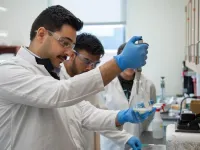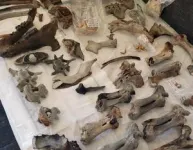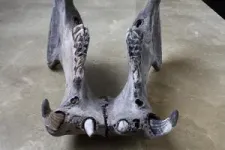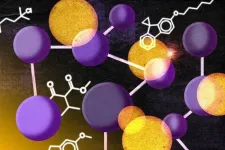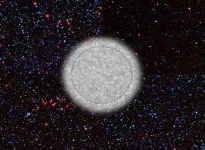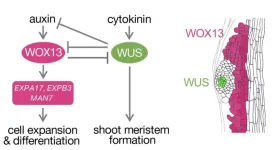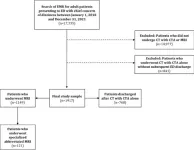(Press-News.org) UNIVERSITY PARK, Pa. — The ability to regenerate and pattern blood vessels, the literal lifelines extending deep into soft tissues, remains an elusive milestone in regenerative medicine. Known as tissue revascularization, stimulating blood vessel growth and pattern formation in damaged or diseased tissues could accelerate the field of regenerative medicine, according to Penn State researchers.
With a four-year, $3 million grant awarded by the National Institutes of Health’s National Heart, Lung, and Blood Institute, Penn State chemical engineering and reconstructive surgery researchers plan to develop a new way to help restore soft tissue loss in patients through two coordinating revascularization techniques.
“Tissue revascularization is a bottleneck for regenerative medicine,” said principal investigator Amir Sheikhi, assistant professor of chemical engineering in the College of Engineering, who also has an affiliation with biomedical engineering. “This is an important award for the whole field, as we hope to develop a fundamentally new way to tackle the problem using a transdisciplinary team.”
When repairing a traumatic injury, surgeons must be able to restore blood flow rapidly to grafts, flaps and engineered scaffolds. However, this is not always feasible using conventional techniques, according to researchers.
The researchers plan to combine a class of protein-based granular hydrogel biomaterials pioneered by Sheikhi, with a microsurgical tactic known as vascular micropuncture, developed by co-principal investigator Dino Ravnic, Huck Chair in Regenerative Medicine and Surgical Sciences, associate professor of surgery at the Penn State College of Medicine, and an attending plastic surgeon at the Penn State Health Milton S. Hershey Medical Center.
Bulk hydrogel scaffolds — polymer networks that can hold a large amount of water while maintaining their structure — have been used over the past few decades as a platform to restore soft tissues during surgical repair, according to Sheikhi, but they often suffer slow and random vascularization effects upon implantation.
To address the limitations of bulk hydrogels, Sheikhi said he plans to engineer protein-based granular hydrogel scaffolds by attaching microscale hydrogel particles to each other.
“By adjusting the empty spaces among the hydrogel particles, we can regulate how cells interact with each other and assemble, guiding tissue architecture and the formation of new blood vessels,” Sheikhi said.
At the same time, researchers will implement vascular micropuncture, where Ravnic and his team will puncture blood vessels with microneedles to accelerate the formation of new blood vessels. The tiny size of the needles ensures there is no blood clotting or significant bleeding.
“Our microsurgical approach allows for targeted blood vessel formation without the use of any added growth factors or molecules,” Ravnic said. “This is exceedingly relevant to advancing tissue engineering and also in treating blood vessel-related conditions.”
The researchers will first test their approach using human cells cultured in vitro from patient samples. Once they establish a baseline understanding of the approach at the cellular level, they will test it in rodents.
The combination of the two techniques, researchers predict, will allow for new blood vessels to rapidly form in an architecturally organized manner. The hierarchical formation — the organization of blood vessels from big to medium to small — helps regulate blood flow, diffuse oxygen and modulate immune cells throughout reconstructed or injured soft tissue.
“The patterns of blood vessels should resemble tree branches, with a large trunk fanning out into smaller and smaller branches,” Sheikhi said. “The reason is that blood needs to flow from the main vessels deep within tissues through capillaries.”
Shayn Peirce-Cottler, professor and chair of biomedical engineering at the University of Virginia, will collaborate on the grant.
END
Soft tissue restoration, blood vessel formation focus of $3M grant
2023-07-07
ELSE PRESS RELEASES FROM THIS DATE:
Learning the language of molecules to predict their properties
2023-07-07
Discovering new materials and drugs typically involves a manual, trial-and-error process that can take decades and cost millions of dollars. To streamline this process, scientists often use machine learning to predict molecular properties and narrow down the molecules they need to synthesize and test in the lab.
Researchers from MIT and the MIT-Watson AI Lab have developed a new, unified framework that can simultaneously predict molecular properties and generate new molecules much more efficiently ...
Previously unidentified proteins suggest new way to diagnose ovarian cancer
2023-07-07
A study led by Nagoya University in Japan has identified three previously unknown membrane proteins in ovarian cancer. Using a unique technology consisting of nanowires with a polyketone coating, the group succeeded in capturing the proteins, demonstrating a new detection method for identification of ovarian cancer.
The discovery of new biomarkers is important for detecting ovarian cancer, as the disease is difficult to detect in its early stages where it can most easily be treated. One ...
Uncovering secrets of plant regeneration
2023-07-07
Ikoma, Japan – Plants have the unique ability to regenerate entirely from a somatic cell, i.e., an ordinary cell that does not typically participate in reproduction. This process involves the de novo (or new) formation of a shoot apical meristem (SAM) that gives rise to lateral organs, which are key for the plant’s reconstruction. At the cellular level, SAM formation is tightly regulated by either positive or negative regulators (genes/protein molecules) that may induce or restrict shoot regeneration, respectively. But which molecules are involved? Are there other regulatory layers that are yet to be uncovered?
To seek answers to the above questions, a research group led by Nara ...
CT with CTA versus MRI in patients with dizziness
2023-07-07
Leesburg, VA, July 7, 2023—According to an accepted manuscript published in the American Journal of Roentgenology (AJR), patients discharged from the emergency department (ED) after CT with CTA alone could have benefitted from an alternative or additional MRI evaluation, including using a specialized abbreviated protocol for the modality.
Compared with those patients discharged after CT with CTA only, “the use of MRI in select patients presenting to the ED with dizziness was associated with greater frequency of critical neuroimaging results, greater use of echocardiography, ...
Researchers uncover how a genetic mutation can cause individuals with normal cholesterol levels to develop coronary artery disease at a young age
2023-07-07
A novel molecular pathway to explain how a mutation in the gene ACTA2 can cause individuals in their 30s – with normal cholesterol levels and no other risk factors — to develop coronary artery disease has been identified, according to researchers with UTHealth Houston.
The study was published in the European Heart Journal.
“The gene ACTA2 codes a specific protein that has nothing to do with cholesterol,” said Dianna Milewicz, MD, PhD, senior author of the study and professor and director of the Division of Medical Genetics at McGovern Medical School at UTHealth ...
Pain risk varies significantly across states
2023-07-07
BUFFALO, N.Y. – The prevalence of moderate or severe joint pain due to arthritis varies strikingly across American states, ranging from 6.9% of the population in Minnesota to 23.1% in West Virginia, according to a new study led by a University at Buffalo researcher.
The paper published in the journal PAIN is providing new insights − through its novel combination of individual- and macro-level measures − into geographic differences in pain and their causes.
“The risk of joint pain is over three times higher in some states compared to others, with states in the South, ...
The American Society for Nutrition appoints Steven A. Abrams, MD as Next Editor-in-Chief of Advances in Nutrition
2023-07-07
Rockville, MD (July 7, 2023) – Steven A. Abrams, MD, Professor in the Department of Pediatrics at the University of Texas at Austin Dell Medical School has been named the next Editor-in-Chief of Advances in Nutrition. Dr. Abrams is a globally recognized leader in pediatric nutrition whose scientific contributions have helped establish the evidence base on nutrient requirements in infancy, childhood, and adolescence.
Advances in Nutrition is the American Society for Nutrition’s journal that publishes reviews spanning basic, translational, ...
New study suggests blood plasma proteins hold answers to better understanding long COVID
2023-07-07
LONDON, ON – Recently published in The Journal of Translational Medicine, a team at Lawson Health Research Institute has discovered unique patterns of blood plasma proteins in patients with long COVID that could reveal potential drug targets to improve patient outcomes.
Currently, 10-20 per cent of people with a confirmed case of COVID-19 will be diagnosed with long COVID.
“Those patients experience a wide variety of symptoms, which may include fatigue, brain fog and difficulty breathing,” says Dr. Douglas Fraser, Lawson Scientist ...
Ticks may be able to spread chronic wasting disease between Wisconsin deer
2023-07-07
Madison — A new study from researchers at the University of Wisconsin–Madison finds that ticks can harbor transmissible amounts of the protein particle that causes Chronic Wasting Disease (CWD), implicating the parasites as possible agents in the disease’s spread between deer in Wisconsin. Her findings were published in the journal Nature.
CWD is caused by a pathogenic agent called a prion, which can pass from deer-to-deer through contact with things like prion-contaminated soil and infected ...
Doom-and-gloom climate news may scare but also encourage audiences
2023-07-07
UNIVERSITY PARK, Pa. — A team of Penn State researchers investigated how seeing frightening news about climate change day after day may shape the way people feel about the phenomenon and how willing they are to take action to address it.
Christofer Skurka, Jessica Myrick and graduate student Yin Yang found that seeing bad news about climate change can make people more afraid over time, but it also may encourage audiences to think about what society can do to address the problem. They published the results of two separate studies in an article titled “Fanning the flames or burning out? Testing competing hypotheses ...
